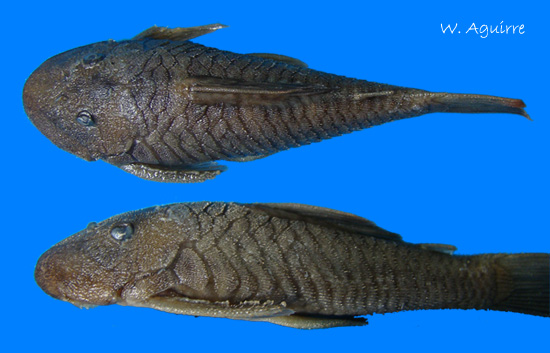| SOURCE FOR OCCURRENCE IN ECUADOR: This species is common in the Guayas and Esmeraldas Rivers. There are many references for its occurrence in the area (e.g., Eigenmann, 1922; Ovchynnyk, 1971; Glodek, 1978; Isbrücker, 1980; Barriga, 1989; Barriga, 1994; Ferraris, 2007; Laaz & Torres, 2010; Eschmeyer, 2011.). |
| ORIGINAL DESCRIPTION: Pellegrin, J. 1909. Mission géodésique de l'Équateur. Collections recueillies par M. le Dr. Rivet. Description de deux poissons nouveaux de la famille des Loricariidae. Bulletin du Muséum National d'Histoire Naturelle (Série 1) 15 (8):517-519. |
| TYPE SPECIMENS: |
| TAXONOMIC STATUS: Valid (Eschmeyer and Fricke, 2011). This species was known as Chaetostoma aequinoctiale until recently when Lujan et al. (2015) reviewed its status and assigned it to the new genus Transancistrus. |
| RANGE ECUADOR: Guayas River drainage (Ferraris, 2007; Laaz & Torres, 2010), Mataje and Santiago Rivers (Barriga, 2012), possibly also in rivers south south of the Guayas like the Santa Rosa River (Jimenez et al., 2015). |
| RANGE OUTSIDE OF ECUADOR: None. |
| COLLECTIONS IN ECUADOR: |
| MAXIMUM SIZE: 7.2 cm (Eigenmann, 1922). |
| DISTINGUISHING FEATURES: Transancistrus aequinoctialis differs from other loricariids in the region by the following characters: having twenty or more spines present on the interopercle, more than any other related species in western Ecuador (Glodek, 1978). |
| ECOLOGY: Transancistrus aequinoctialis is known in Ecuador as the “campeche, guaña”. This is a small, ecologically important detritivorous fish that feeds primarily on algae with its villiform teeth (Barriga, 1994). This species can typically be found under medium sized rocks (Barriga, 1989). |
| ECONOMIC IMPORTANCE: Not of economic importance. |
| CONSERVATION STATUS: Not available. |
| LINK TO FISHBASE PAGE: Click here for link |
| SPECIES PROFILE CREATED BY: Enrique Laaz |
| SPECIES PROFILE CONTRIBUTORS: Windsor Aguirre |
